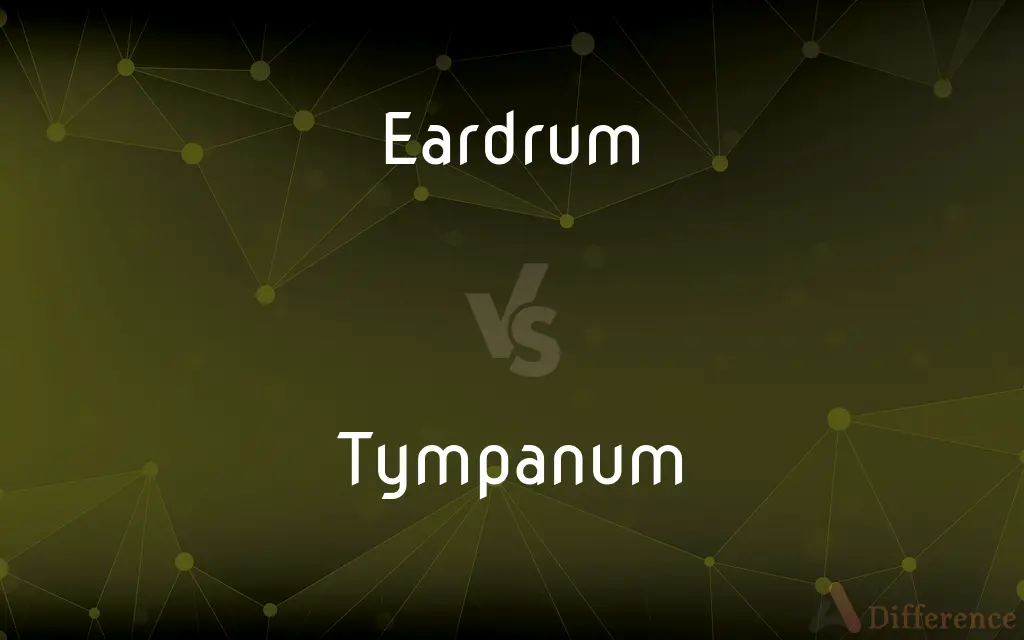Eardrum vs. Tympanum — What's the Difference?
Edited by Tayyaba Rehman — By Fiza Rafique — Updated on April 9, 2024
The eardrum and tympanum refer to the same anatomical structure in the ear, responsible for transmitting sound vibrations to the inner ear.

Difference Between Eardrum and Tympanum
Table of Contents
ADVERTISEMENT
Key Differences
The eardrum, also known as the tympanic membrane, is a thin, cone-shaped membrane that separates the external ear from the middle ear. It plays a crucial role in hearing by vibrating in response to sound waves and transmitting these vibrations to the bones of the middle ear. The term "tympanum" is another name for the eardrum, often used in more formal or scientific contexts.
Both terms describe the same structure and function: converting airborne sound waves into mechanical vibrations. This conversion is the first step in the complex process of hearing, allowing sound to be further processed by the inner ear and then interpreted by the brain.
In terms of health and medical treatment, issues affecting the eardrum, or tympanum, such as perforations or infections, can significantly impact hearing ability. Treatments for eardrum problems may include medications to heal infections or surgery to repair perforations, with the terminology used interchangeably by healthcare professionals.
The eardrum's anatomy includes three layers: an outer layer that faces the ear canal, a middle fibrous layer that provides strength, and an inner layer that faces the middle ear. The structure's design ensures efficient sound transmission while also protecting the middle and inner ear from bacteria and foreign objects.
Understanding the eardrum's (or tympanum's) role in hearing is essential for appreciating how sound is conveyed from our environment to our brain, highlighting the importance of ear health in overall sensory perception.
ADVERTISEMENT
Comparison Chart
Definition
A thin membrane that separates the external ear from the middle ear, vibrates in response to sound.
Another term for the eardrum, used interchangeably.
Function
Transmits sound vibrations to the inner ear.
Identical to the eardrum in transmitting sound vibrations.
Terminology Usage
Commonly used in everyday language and some medical contexts.
Often used in scientific and detailed medical contexts.
Health Implications
Issues like perforations or infections can impact hearing.
Same as eardrum, with treatment options including medication or surgery.
Anatomy
Comprises three layers: outer, middle fibrous, and inner.
Same anatomical structure and layers as the eardrum.
Compare with Definitions
Eardrum
Vibrates in response to sound waves, aiding in sound transmission.
Loud noises can damage the eardrum, affecting its ability to vibrate properly.
Tympanum
Identical to the eardrum, converting sound waves into mechanical vibrations.
The tympanum's vibration is the first step in the mechanical process of hearing.
Eardrum
A crucial component of the ear for hearing, separating external and middle ear.
The doctor examined her eardrum for signs of infection.
Tympanum
Affects hearing when damaged or infected, similar to the eardrum.
Tympanum damage can lead to temporary or permanent hearing loss.
Eardrum
Susceptible to infections and perforations, affecting hearing.
A perforated eardrum can cause hearing loss and requires medical attention.
Tympanum
Scientific term for the eardrum, involved in the hearing process.
The tympanum's integrity is vital for effective sound transmission to the cochlea.
Eardrum
Consists of three layers, each serving a specific function.
The fibrous middle layer of the eardrum provides it with the necessary strength.
Tympanum
Shares the same three-layered structure as the eardrum.
The tympanum's outer layer is contiguous with the skin of the ear canal.
Eardrum
Infections treated with medication, perforations might need surgical repair.
Minor eardrum tears often heal on their own, but severe cases may need surgery.
Tympanum
Same approaches as for eardrum issues, including watchful waiting or surgery.
Tympanoplasty might be considered for repairing a severely damaged tympanum.
Eardrum
In the anatomy of humans and various other tetrapods, the eardrum, also called the tympanic membrane or myringa, is a thin, cone-shaped membrane that separates the external ear from the middle ear. Its function is to transmit sound from the air to the ossicles inside the middle ear, and then to the oval window in the fluid-filled cochlea.
Tympanum
(Anatomy)See middle ear.
Eardrum
The thin, semitransparent, oval-shaped membrane that separates the middle ear from the external ear. Also called tympanic membrane, tympanum.
Tympanum
See eardrum.
Eardrum
(anatomy) A thin membrane that separates the outer ear from the middle ear and transmits sound from the air to the malleus.
Tympanum
(Zoology)A membranous external auditory structure, as in certain insects.
Eardrum
The tympanum. See Illust. of Ear.
Tympanum
The ornamental recessed space or panel enclosed by the cornices of a triangular pediment.
Eardrum
The membrane in the ear that vibrates to sound
Tympanum
A similar space between an arch and the lintel of a portal or window.
Tympanum
The diaphragm of a telephone.
Tympanum
(archaic) A drum.
Tympanum
Any of various anatomic structures in various animals with analogy to a drum head:
Tympanum
The eardrum (tympanic membrane, membrana tympanica).
Tympanum
The main portion of the middle ear: the tympanic cavity (cavitas tympani).
Tympanum
A thin tense membrane covering the hearing organ on the leg or body of some insects, sometimes adapted (as in cicadas) for producing sound.
Tympanum
(zootomy) A membranous resonator in a sound-producing organ in frogs and toads.
Tympanum
(zootomy) in certain birds The labyrinth at the bottom of the windpipe.
Tympanum
(architecture) A vertical recessed triangular space between the sides of a pediment, typically decorated
Tympanum
The recessed triangular space within an arch, and above a lintel or a subordinate arch, spanning the opening below the arch
Tympanum
(engineering) A drum-shaped wheel with spirally curved partitions by which water is raised to the axis when the wheel revolves with the lower part of the circumference submerged; used for raising water, as for irrigation.
Tympanum
The ear drum, or middle ear. Sometimes applied incorrectly to the tympanic membrane. See Ear.
Tympanum
One of the naked, inflatable air sacs on the neck of the prairie chicken and other species of grouse.
Tympanum
The recessed face of a pediment within the frame made by the upper and lower cornices, being usually a triangular space or table.
Tympanum
A drum-shaped wheel with spirally curved partitions by which water is raised to the axis when the wheel revolves with the lower part of the circumference submerged, - used for raising water, as for irrigation.
Tympanum
The main cavity of the ear; between the eardrum and the inner ear
Tympanum
The membrane in the ear that vibrates to sound
Tympanum
A large hemispherical brass or copper percussion instrument with a drumhead that can be tuned by adjusting the tension on it
Common Curiosities
How does the eardrum/tympanum contribute to hearing?
It converts sound waves into mechanical vibrations, transmitting them to the inner ear.
What happens if the eardrum is damaged?
Damage can lead to hearing loss, pain, and increased risk of ear infections.
Can a damaged eardrum heal on its own?
Many eardrum perforations heal spontaneously, but severe damage may require surgical intervention.
What is the eardrum?
The eardrum is a thin membrane that vibrates in response to sound, playing a key role in hearing.
How is damage to the eardrum/tympanum diagnosed?
Through an otoscopic exam, where a doctor looks at the eardrum using a special instrument.
What are the symptoms of an eardrum problem?
Symptoms can include ear pain, hearing loss, tinnitus, and sometimes discharge.
Is tympanum used in any context outside of medicine?
Yes, in entomology, tympanum can refer to a membrane used for hearing in some insects, showing the term’s broader usage beyond human anatomy.
Is there a difference between the eardrum and the tympanum?
No, the eardrum and tympanum refer to the same anatomical structure in the ear.
What is tympanoplasty?
Tympanoplasty is a surgical procedure to repair a perforated eardrum/tympanum.
What causes eardrum perforations?
Causes include infections, loud noises, abrupt pressure changes, or physical trauma.
What treatments are available for eardrum/tympanum issues?
Treatment options range from antibiotics for infections to surgery for serious perforations.
Can eardrum perforations affect balance?
While balance issues are more directly related to the inner ear, severe middle ear problems, including those affecting the eardrum, can sometimes influence balance.
Can you prevent eardrum/tympanum damage?
While not all causes are preventable, reducing risk factors like loud noise exposure and managing ear infections can help protect the eardrum.
How can I protect my eardrum/tympanum from damage?
Avoid inserting objects into the ear, limit exposure to loud noises, and treat ear infections promptly.
Does the eardrum have any protective functions?
Yes, it helps protect the middle and inner ear from foreign objects and bacteria.
Share Your Discovery

Previous Comparison
Corrode vs. Rust
Next Comparison
Chromite vs. ChromiumAuthor Spotlight
Written by
Fiza RafiqueFiza Rafique is a skilled content writer at AskDifference.com, where she meticulously refines and enhances written pieces. Drawing from her vast editorial expertise, Fiza ensures clarity, accuracy, and precision in every article. Passionate about language, she continually seeks to elevate the quality of content for readers worldwide.
Edited by
Tayyaba RehmanTayyaba Rehman is a distinguished writer, currently serving as a primary contributor to askdifference.com. As a researcher in semantics and etymology, Tayyaba's passion for the complexity of languages and their distinctions has found a perfect home on the platform. Tayyaba delves into the intricacies of language, distinguishing between commonly confused words and phrases, thereby providing clarity for readers worldwide.
















































